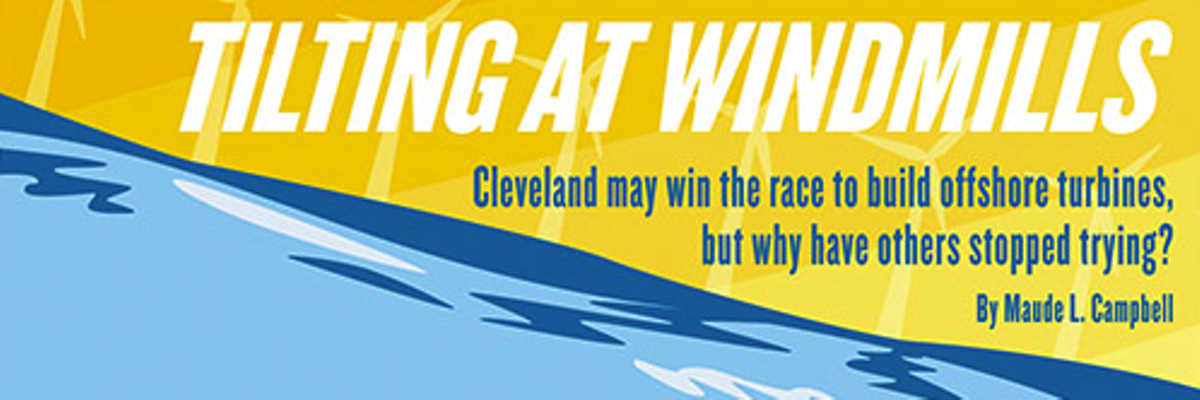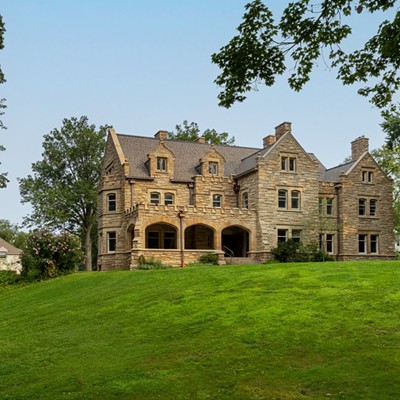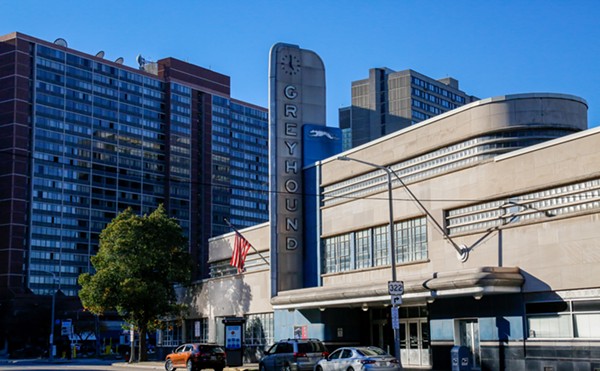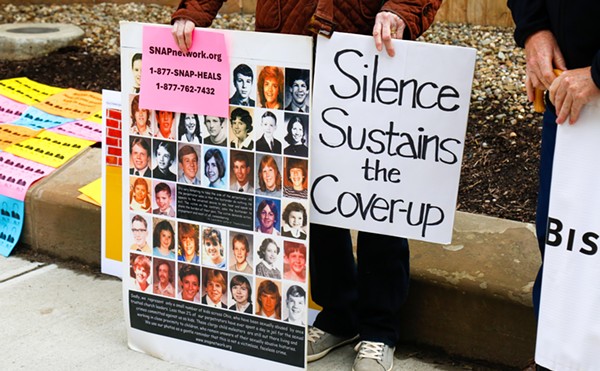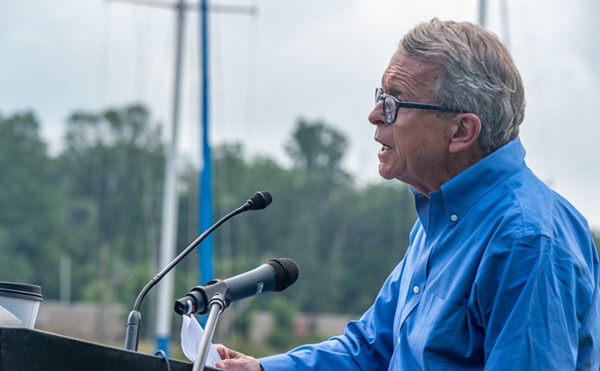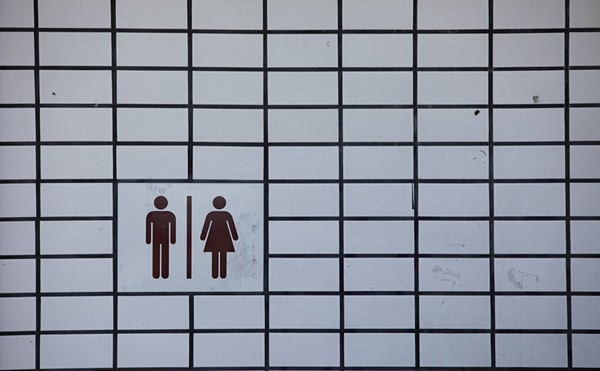Lorry Wagner will talk to any community group that will have him. And his message has been the same for years: Cuyahoga County's effort to install five wind turbines off the coast of Lakewood will start something very big for our downtrodden region.
But we've got to be first at this game. Ohio must develop an offshore wind farm in Lake Erie before New York and Ontario do. And both of them are on our heels.
A lifelong boater and an active scuba diver at 59, Wagner took up climbing the massive wind turbine towers that dot Europe several years ago. He is a nuclear engineer by trade, but "Nuclear is never coming to Ohio again," as he puts it.
Wagner is convinced that thousands of turbines off the shores of Lake Erie are our best bet for ditching coal power. But when the South Euclid native speaks to area residents, he presents his eco-beliefs almost as an aside. Instead, he aims to rally everybody around jobs, whether or not they believe in the power of wind.
"We need to capture something for this region to help it economically," Wagner says with an energy that suits his fit frame; his sincere enthusiasm for the promise of offshore wind keeps audiences listening.
"We missed the IT revolution, the silicon revolution, and the biotech revolution, and this region is suffering for it."
As long as Cleveland is first to put turbines in the water, his logic goes, we can become the epicenter for the region's offshore wind industry — which, by the way, is poised to explode: Air rushes over the Great Lakes' watery expanses with optimal vigor that so far is untapped.
Cleveland could be home to the region's first skilled offshore construction crews, which other states and Canada would rely upon. The concrete business will boom as more and more turbine foundations are built here. Our vacant offices will teem with firms specializing in wind energy research, offshore permitting and regulation, and related issues.
Wagner imagines a revamped port becoming more lucrative than it was in the city's early 20th-century heyday. Only this time, dock workers will not be hauling iron ore and steel, but rotor blades that stretch more than half a football field in length.
If all goes as planned, we may launch a new era of shipbuilding here, as specialized vessels are needed to deliver and install the enormous turbine parts in the lake bed.
The ultimate success, says Wagner, would be to demonstrate enough offshore wind-building activity flowing through Cleveland to lure a major turbine manufacturer to set up shop here. (The large parts of wind turbines are now made mostly in Europe and China.)
As president of the Lake Erie Energy Development Corporation, Wagner is charged with setting this dream into motion. The first five turbines are slated to go up by late next year. LEEDCo aims to erect 250 of them by 2020 and expand from there.
The company has allies in the City of Cleveland, Cuyahoga County, and key business interests, and has heard nothing along the lines of opposition to the plan. But outside of Ohio, thousands of people are failing to warm up to Wagner's vision.
The problem?
"Imagine a lake that looks like a pincushion," says one opponent of offshore turbines.
A 2010 report from the National Renewable Energy Laboratory says that Lake Erie alone can accommodate enough turbines to light up almost a third of Ohio's homes. But to reach that capacity, the lake would need to sport about 11,500 of the biggest wind turbines ever made — and they would occupy almost half its total area.
To these anti-wind groups, Cleveland is already the epicenter of the region's offshore wind industry. But in the wrong way.
Lorry Wagner's mission is rooted in a statewide initiative spurred by a renewable energy report issued in 2004 and supported by former Governor Ted Strickland. Reacting to federal pleas for renewable energy development — as well as new national clean air and water laws — Strickland's administration and Cuyahoga County hit on wind energy as the most viable direction for Ohio. Not only was Lake Erie a wind resource waiting to be developed, but such an industry here might revive our dying manufacturing base.
Cleveland and Cuyahoga County moved quickly ahead. In 2005, the city installed an offshore monitoring tower to learn just how suitable lake winds are for spinning turbine blades.
A year later, the county commissioners formed the Great Lakes Energy Task Force, installing Prosecutor Bill Mason at its helm — a position he still holds today. That year, Wagner and his Solon company, Azure Energy, installed the 150-foot turbine at the Great Lakes Science Center. (Lake turbines will be at least three times the size, he notes.)
Azure focuses on smaller solar and wind installations, and buys used turbines from Europe to refurbish for use in the U.S. Given his expertise, Wagner was a good fit for a Task Force seat alongside other business and community leaders.
In 2007, the Task Force recommended that a small offshore wind project proceed, and the county hired a German company to conduct a feasibility study that reported more happy news. The offshore wind effort received another boost with the 2008 Ohio law mandating that 25 percent of the state's energy come from renewable sources by 2025.
LEEDCo was formed in 2009 as an economic development corporation: a collaboration between Cuyahoga and Lorain counties, the Cleveland Foundation, the City of Cleveland, and NorTech Energy. (Lake and Ashtabula counties have since been brought into the fold.) A year later, Wagner was named president.
The company's purpose is to ensure that the offshore wind industry benefits area companies, creates jobs here, and brings new business to the region.
"This is the kind of thing that is truly regional," Wagner says. "The four counties got together to make sure the economic development happens." The coalition is aimed at discouraging outside developers from going it alone without working through LEEDCo.
"If a developer came into just Ashtabula wanting to put turbines in the lake, then you get poaching and no economic development," says Wagner.

